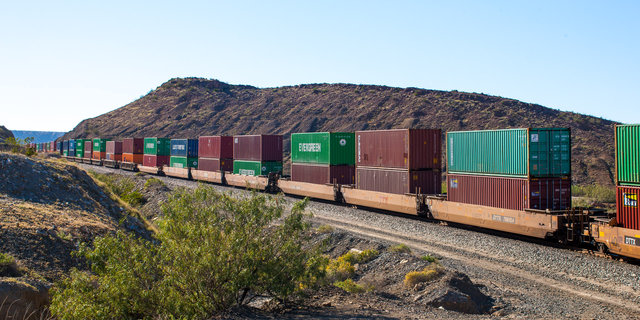
July 25, 2023
What Is a Well Car Rail Car?
In the 1980s, intermodal containers became widely used by railroads. Originally, containers were loaded onto flatcars for transport by rail. But that presented a problem: Even though shipping containers could be stacked on top of one another, when two containers were stacked on a flatcar, they were simply too tall to ship them that way safely. Not only could tunnel and bridge clearances not handle their height, but it also made for a dangerously high center of gravity. Shipping just one container per flatcar was inefficient, since it limited the railroads’ opportunities to literally double the number of containers per train.
Enter the well car. Well cars are like an evolved flatcar: they look and work much the same, but have a depression in the middle that allows containers to fit snuggly inside and, more importantly, helps them to ride lower than on a flatcar. The extra room matters – with well cars, railroads can stack two containers onto one car, yielding huge efficiency gains per train. Today, it’s common to see entire trains of well cars, each carrying two containers stacked on top of one another, traversing the countryside from ports to inland markets and vice versa.

What Are Well Cars Used For?
Well cars are used to ship intermodal containers. Shipping containers themselves can hold a wide variety of goods, so really just about anything could be riding on a well car.
What Does a Well Car Look Like?
Well cars look similar to flatcars but have a depression between the wheel trucks of the car that lets intermodal containers sit closer to the rails. By allowing intermodal containers to be carried lower than on a flatcar, this “well” is what allows railroads to stack shipping containers on top of one another so that each car can hold two containers.
What Are the Different Types of Well Cars?
Well cars come in a variety of sizes. The size of a well car is based on the size of the containers it carries. The most common are 40 feet, 48 feet and 53 feet. There are also rail cars known as "all-purpose" well cars, which are equipped with hitches that also allow them to carry semi-trailers.

How Are Well Cars Loaded and Unloaded?
Containers are lifted off of and onto well cars using a container crane. When two containers are stacked on a well car, the top container is secured to the bottom one. When the containers are the same size, they are often secured by a bulkhead built into the well car. Shipping containers can also be secured using inter-box connectors (IBCs) or “twistlocks.” Containers must then by unlocked from each other before unloading.
Well Car Fun Facts
- Well cars are also referred to as double-stack cars, stack cars or well wagons.
- Entire trains of well cars with stacked intermodal containers are often called “stack trains.”
- Nearly 70 percent of United States intermodal shipments are shipped using double-stack rail transport.
- The first double-stack intermodal car was developed in 1977, but its popularity was slow to rise. Finally in 1984, American President Lines (now APL) worked with Union Pacific Railroad to launch the first all double-stack train that same year.

Learn More
To learn more about well cars, intermodal shipping, or how much it costs to ship by rail, answer a few questions about your shipment and an expert will be in touch,
Want to learn more about other types of rail car equipment, including auto racks, covered hoppers, flatcars, tank cars, boxcars and gondolas? Check out our rail car type guide.
Related Articles
- Rail Car Types Defined
- What Is Intermodal Shipping...and Why Should Shippers Care?
- What's the Difference Between Intermodal and Transloading?
- Creative Uses of an Intermodal Container
- Rail Shipping Steps: #1 Answer These 7 Questions About Your Shipment
- Shipping by Rail 101: FAQs Answered
- Pros & Cons of Freight Shipping Modes: Truck, Rail, Water & Air Compared
- Quiz: Is Intermodal Right for Your Freight Shipments?